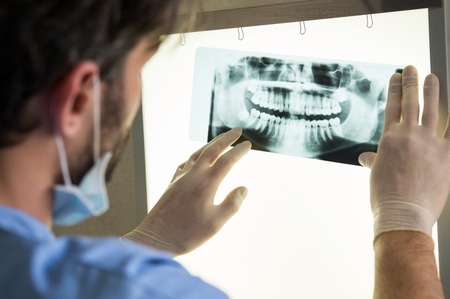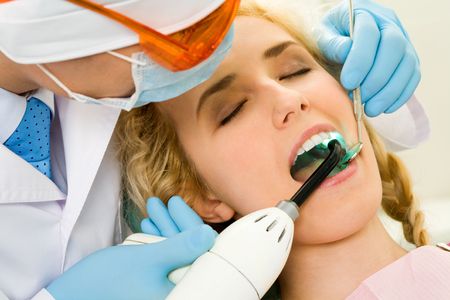Finding out that you have cracked tooth syndrome early on is crucial in fixing it before the tooth gets so damaged that it needs to be extracted. Unfortunately, the symptoms associated with cracked tooth syndrome are so variable and similar to symptoms for other more common ailments, like sinusitis or head aches, making it one of the most difficult dental issues to diagnose.
Because cracked tooth syndrome most often occurs on the premolars or molars, and is typically an incomplete hairline fracture, even the most advanced x-ray images will have difficulty identifying the crack. As a result, dentists usually have to perform a complete oral examination, which consists of several diagnostic tests, to confirm if it is in fact cracked tooth syndrome.

Below is a description of the most common diagnostic tests that a dentist may perform to determine if the symptoms described by a patient is due to cracked tooth syndrome.
Examine the patients dental history
The first thing a dentist may do when a patient informs them of cracked tooth symptoms without being able to visually detect a cracked tooth cracked tooth is review their dental history to determine if what they have is cracked tooth syndrome. By doing this, the dentist can see if any extensive dental work has been done to the patient in the past which may have put too much pressure on some of the teeth.
They can also look in the history to determine if the patient has had a cracked tooth in the past or if they have reported taking part in activities or showing habits that often lead to cracked teeth. With this information, the dentist can have a better idea of whether the symptoms described are due to a cracked tooth and move on to further diagnostic test to confirm their suspicions.
Perform clinical examinations on the effected quadrant
Most of the time, the patient will have trouble determining exactly which tooth is hurting, and instead will feel the pain in the entire quadrant of the mouth where the cracked tooth is located. Knowing the region of the mouth that is experiencing symptoms, the dentist can examine the quadrant to look for:
- teeth that are more susceptible to damage. For example, a molar that may be more prone to damage from an opposing molar with a large cusp that can damage the opposing tooth when biting down hard.
- teeth that are sensitive to common stimuli of cracked tooth symptoms such as cold temperature or sweets.
- gum tissue that looks like it is infected near a specific tooth. This may indicate that there is a crack below the gum line.
By doing this examination, a dentist may be able to figure out specifically which tooth is the one causing the symptoms. This will lead to further tests in order to determine if in fact the tooth is suffering from cracked tooth syndrome and the extent of the damage.
Bite testing
Bite tests are a great way to determine which tooth may have a partial fracture that is causing the symptoms experienced by the patient. This is a great way to single out a tooth by asking the patient to bite down on a specific object in order to mimic the symptoms felt.
One way of conducting this test is to ask a patient to bite down on a Tooth Slooth, a probe designed specifically for bite tests. The Tooth Slooth has one end with a triangular shape on it. The patient is asked to bite down on the pointed end of the triangle with each tooth in the effected quadrant until one of the teeth triggers a symptomatic response. This will indicate that the tooth which reacted may have cracked tooth syndrome.
Sometime, however, the symptoms are experience when the bit pressure is released instead of when biting down. Cotton rolls are often used to test this by asking the patient to bite down on the cotton roll and release pressure quickly. If the symptoms arise, this can be indication of a cracked tooth.
Trans-illumination testing
Trans-illumination is one of the most commonly used methods of determining if a tooth is cracked or fractured. Teeth that are suspected to be cracked are illuminated from several angles with a powerful fibre optic light to see if the light illuminates the entire tooth.

If there is some variation in the light, or the light only passes through a portion of the tooth, this is a good indication that there is a crack in that tooth. The only drawback with this testing is that it may indicate that a minor problem, like a craze line, is a crack, meaning that further test will be required to supplement that diagnosis.
Tactile tests
Another way to find a small crack, and the extent of the crack on a specific tooth is to carefully examine the surface of the tooth. Since visually inspecting it is nearly impossible with cracked tooth syndrome, tactile tests are a great alternative.
By using a metal probe with a sharp and point tip, a dentist can carefully scratch the surface of the tooth until the pointed tip catches on something. If it does, this is clear indication that the tooth is cracked.
Removing previously placed restorations
Sometimes a crack that is causing symptoms is occurring beneath a previously restored tooth. For example, the crack may be beneath a dental crown or a filling placed earlier in the patients life. If this is the case, the only way to confirm the suspicion is to remove the restoration and perform diagnostic testing on that tooth.

Dye testing
This type of test uses methylene blue or gentian violet dyes to stain the suspected tooth and highlight any potential fractures. Dye testing is not a very popular choice for diagnosing cracked tooth syndrome because it can take several days to work, however, it is an effective way of finding a crack if all else fails.